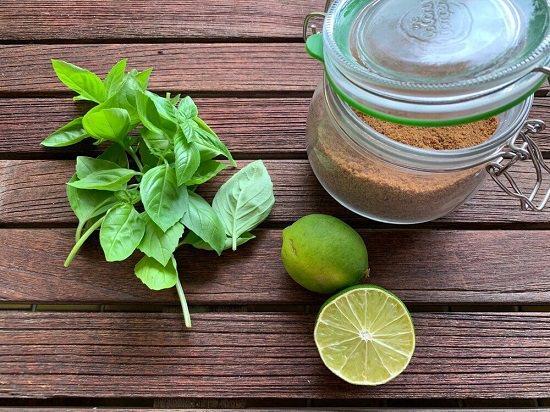Basic kitchen ingredients might help in managing vitiligo effectively. Learn how you can use basil leaves and lime juice for vitiligo below!
What is Vitiligo?
Vitiligo is a chronic skin disease characterized by depigmentation of the skin due to the death or failure of epidermal melanocytes, the skin cells that produce melanin. The person’s immune system attacks the melanocytes. As a result, the skin loses its natural color, and patches of lighter skin develop on the body. The discolored areas grow bigger with time. Vitiligo can affect the skin on any part of the body, the hair, and even the inside of the mouth. Vitiligo doesn’t have a cure but you can lessen or slow down the process with remedies. Use basil leaves and lime juice for vitiligo to manage the spots and lessen them even.
Symptoms
The symptoms of vitiligo include
- Patchy loss of skin color appearing in the hands, face, and areas around body openings
- Premature whitening or greying of hair, eyelashes, and eyebrows
- Loss of color in the eyes, and the nasal and oral mucous membranes.
It can affect people of all skin types but is more noticeable in people with darker complexions. Vitiligo generally appears before 30 years of age, and the prevalence of vitiligo in the general population is 0.5 – 2%. The condition is neither contagious nor harmful but can cause psychological distress and low self-esteem.
Causes
Vitiligo could be due to hereditary factors, endocrine disorders, immune system disorders, connective tissue diseases, and/or excess sun exposure. Skin trauma from toxins or chemicals, and emotional or mental stress can lead to vitiligo too. Vitiligo commonly affects people with liver problems or other autoimmune conditions like type 1 diabetes, psoriasis, lupus, rheumatoid arthritis, or thyroid disorders. It can cause your skin to be highly prone to sunburns and, in rare cases, cause vision and hearing problems as well.
Basil Leaves and Lime Juice for Vitiligo
Basil leaves have anti-aging, antioxidant, and antiviral properties, making them effective against skin problems. Adding lime juice to basil leaves helps improve melanin production in the skin cells. Take a handful of fresh basil leaves and wash them well. Chop the leaves into small pieces, then pound them in a mortar and pestle. Alternately, blend the leaves in a blender and extract the juice.
Add the juice of half a lime to the crushed leaves. Mix well and apply the mixture to the discolored patches. Leave it on for 30 minutes, and then rinse off with warm water. Repeat this thrice a day for at least six months to see visible results. This treatment is natural and has no side effects.
Other Home Remedies
1. Papaya and Turmeric
You can consume papaya juice or apply slices of papaya on the patches to reduce skin discoloration. Papaya is infamous for increasing melanin production in the skin and treating skin pigmentation naturally. Alternatively, you can apply a mixture of turmeric powder and mustard oil in a 1:2 ratio on the patches. Turmeric effectively reduces dark spots on the skin and evens out the skin tone.
2. Red Clay and Ginger
Make a mixture of red clay and ginger juice in a 1:1 ratio and apply it to the discolored patches. It helps in reducing discoloration as red clay contains copper, and ginger has potent phytochemicals that boost circulation and induce pigmentation.
3. Radish Seeds and Vinegar
Soak a handful of radish seeds in vinegar overnight and make a paste out of this the following morning. Apply the paste on the affected skin area and keep it on until it comes out as scales. Wash your face and apply a natural moisturizer.
4. Neem and Honey
Neem leaves are a savior for skin since old times. When combined with honey, neem leaves can effectively reduce vitiligo patches. Mix a teaspoon of honey in half a glass of neem juice and drink it three times a week. You can apply a paste of bakuchi (Psoralea caryfolia) and vinegar as well.
5. Walnut and Hydration
Consume five walnuts daily or make a paste by blending walnuts with water and apply on the patches. Drinking plenty of water, especially copper-infused water will go a long way in fighting vitiligo and/or general skin pigmentation.
6. Eating Habits
Make it a habit to consume a nutritious diet with immune-boosting foods containing antioxidants, zinc, copper, and vitamin C. Include bananas, apples, radish, carrots, chickpeas, leafy greens, root vegetables, figs, and dates in your daily diet. Besides, eggs, dairy products, fish, poultry, soy products, and nuts are good options as well. To minimize your risk of getting vitiligo, avoid stress and sun exposure.
When to See a Doctor
Visit your doctor once you notice any discoloration on your skin, hair, or mucous membranes. Your doctor will ask about your medical history, do a physical examination, and prescribe other tests to diagnose your condition. Vitiligo has no cure, but there are treatments available that can stop or slow the condition’s progress and restore some color to the affected skin.




